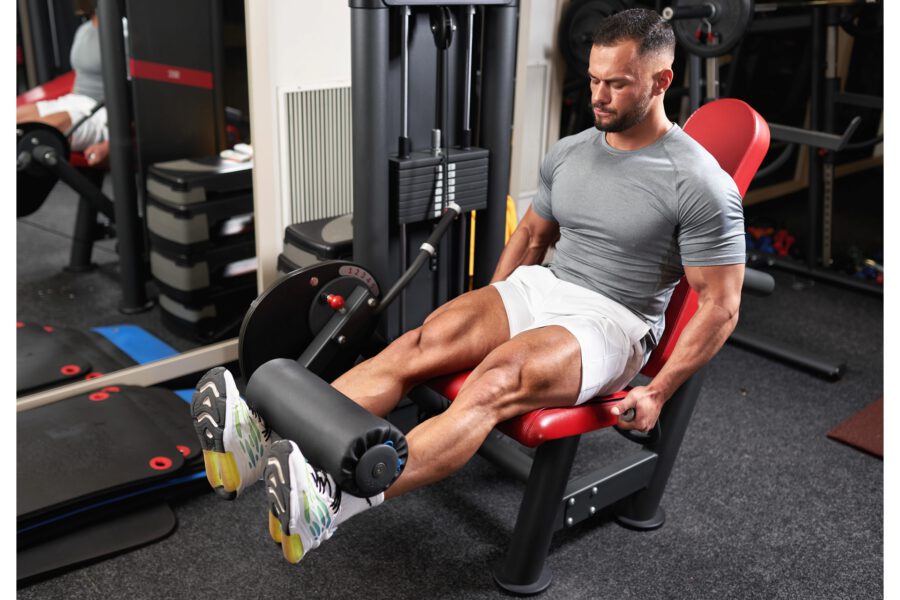Open vs. Closed Chain Exercises; Which is Best?
There are several ways to classify exercises in the gym. One that Is frequently misunderstood is the distinction between open and closed chain exercises. In this article, I’ll lay out what that difference is and discuss which is best for various applications.
An open chain exercise is one in which your limbs can move freely through the air rather than pushing against a solid object. Examples of open chain exercises are leg extensions and biceps curls. Exercises, where your hands are moving with dumbbells or cables in them, are also open chain.
Closed chain exercises are those in which your limbs are connected to a surface. Examples of closed chain exercises are squats and push-ups. Parallel bar dips are another example of a closed chain exercise because, even though your torso is moving up and down through space, your hands are fixed against the dip bar.
The chain that is referred to is the body’s kinetic chain, that being the connection between the muscles and bones that make up your body. With a closed chain movement, the further part of the body’s bones and musculature is fixed so that it pushes against the surface.
You generally find that the classification between open chain and closed chain exercises mirrors that between compound and isolation exercises. Open chain exercises more readily allow you to isolate and target a muscle group, such as when you do a leg extension to work the quadriceps. Closed chain exercises, such as squats, work several muscle groups together.
When you do closed chain exercise, movement in one muscle produces a chain reaction of movement in other muscles. As an example, when you do a squat, movement at the knee joint, generates movement at the hip and ankle joints.
Imagine that you are doing a standing calf raise on a calf raise machine. Your toes are connected to a foot block and your body moves up and down to contract and extend the calf muscles. Because you are pushing against an immovable object (the calf block), this would be considered a closed chain exercise.
However, if you go on a 45-degree leg press machine to perform a calf raise with your toes toward the bottom of the platform and your heels under it, you would be doing an open chain exercise. That’s because the balls of your feet are moving away from you and you are the stable object.
The calf muscle would not know the difference between these open chain and closed chain exercises. The only thing that the calf muscle knows is that it is pulling on a tendon which, in turn, pulls on the heel bone to cause the forefoot to go forward.
The point here is that the target muscle doesn’t know whether you are moving or something else is moving. Another example is when you are doing a pull-up. Your lats don’t know whether you are rising to the pull-up bar, which would be a closed chain exercise, or whether you are doing a lat pulldown and the bar is moving toward you (open chain).
So, to make a broad classification that one type of exercise (open or closed chain) is better than the other based purely on that classification is clearly nonsensical.
The consensus among the fitness community has been that closed chain exercises are better than open chain exercises for two main reasons:
- Multiple muscle groups are working together in a compound fashion to make the exercise ‘more effective’.
- Closed chain exercises are safer for your joints.
Let’s consider these points in a bit more detail.
If your goal is to develop muscular strength and size, then your goal should be to isolate the working muscle. So, if you want to develop your quads, the best exercise will be one where your quads are doing all the work.
Of the two types of exercise, open chain exercises are better at isolating the working muscle.
Some will argue that a closed chain exercise will allow you to place co-contractive force on a muscle from both sides so that the joint isn’t just being pulled on from one side. They may cite the squat, where the quadriceps extend the knee and the hamstring helps to extend the hip which provides co-contraction in the front and the back of the thigh. This means that the knee isn’t being pulled on from just one side, as it would in an open chain exercise.
This explanation, however, completely ignores the principle of reciprocal inhibition. By this principle, an opposing muscle group shuts off when its opposite turns on. So, when you activate your quads in the squat, the hamstrings shut off. As a result, there is no such thing as a contractive force on the quads and the argument that the joint is better protected falls apart.
Those who claim that closed chain exercises are inherently better than open chain exercises will also cite the claim that open chain exercises can cause knee shearing. The prime example they cite is the leg extension. The term knee shearing refers to a shifting of the upper end of the tibia from the lower end of the femur when you do the exercise. However, the anchoring effect achieved by the upward pull of the quadriceps tendon is far greater than the perpendicular resistance applied at the front of the ankle, completely negating any danger of tibia displacement. So, the idea that your knee can shear when you do open chain exercises like leg extensions is, in fact, sheer nonsense.
A workout you should try:
Both closed chain and open chain exercises have their place in a well-rounded exercise program. As we’ve seen the bias against open chain and in favor of closed chain exercises is based on faulty logic and misinformation. If your goal is to build muscle then you should prioritize open chain exercises that allow you to isolate and work the target muscle through its range of motion. If, however, your objective is to get as strong as possible and lift the maximum amount of weight, then closed chain exercises should be emphasized more in your program.
Frequently Asked Questions
Open chain exercises are movements where your limbs move freely through the air, not pushing against a solid object. Examples include leg extensions and bicep curls. These exercises are great for isolating specific muscle groups.
Closed chain exercises involve your limbs being connected to a surface, such as during squats or push-ups. These exercises typically engage multiple muscle groups and are effective for building overall strength.
The choice between open and closed chain exercises depends on your fitness goals. Open chain exercises are ideal for isolating muscles, while closed chain exercises are better for compound movements that build overall strength. Consider incorporating both for a balanced workout.
Yes, combining both open and closed chain exercises in your workout can provide a comprehensive fitness routine. This approach allows you to isolate specific muscles while also engaging multiple muscle groups for overall strength.
Open chain exercises often focus on isolating and targeting specific muscles, leading to increased activation in those areas. Closed chain exercises, on the other hand, tend to activate multiple muscle groups simultaneously, promoting overall strength and stability.
Closed chain exercises are generally more effective for building functional strength because they mimic real-world movements and engage multiple muscle groups. They help improve balance, coordination, and overall body stability.
The Gymaholic App offers features for tracking both open and closed chain exercises, helping you monitor progress and optimize your workouts. It provides personalized workout plans and detailed analytics to enhance your fitness journey.

